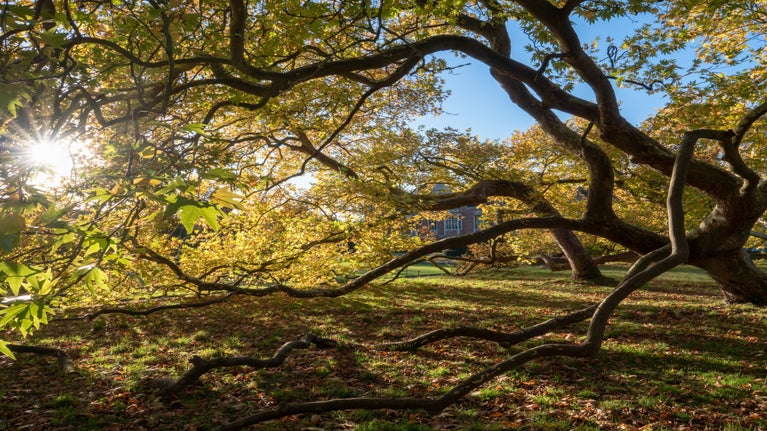
Trees and plants
We care for 25,000 hectares (61,776 acres) of woodland, 135 wild landscape sites and more than 200 gardens, and have as many wonderful stories to tell.

Often used to illustrate fairy tales and folklore, fungi remind us of mythical creatures and childhood stories. From rock hard, black fungi named after the legend of King Alfred’s burnt cakes to tiny orange ones that look like pieces of orange peel, the sheer variety of British fungi is astonishing. Find out all you need to know about these fascinating organisms, and why they are so important.
Not categorised as a plant, fungi are organisms that live under the ground or on their host. They form a colony of tiny branching threads called mycelium.
The parts of the fungi we see above ground are the fruiting bodies. This part contains spores, similar to seeds in as much as they are for reproduction, which are dispersed to produce future colonies. Some fungi shed their spores from below, some by expelling them with force and others in liquid form.
Fungi don’t photosynthesise as they don’t have any chlorophyll, so they get their energy from their growing medium, which might be leaf litter, rotting wood or decaying creatures.
They come in many shapes, sizes and colours, and can be found by looking high and low, particularly in woodland, with most appearing in autumn.
In the UK relatively few of our fungi are poisonous, although some would make you feel pretty unwell if you ate them.
There are two particularly dangerous ones with fabulous names: the death cap and the destroying angel. Unless you’re a very experienced mycologist (fungi expert) it’s best to play safe and just look, but don’t touch.
We ask that if you do find some interesting fungi at our places to leave it where you found it and just take a picture instead. Fungi play their part in the habitats they are found in and we need to do all we can to protect the ecology of our woodlands and parks.

Fungi are a vital part of the natural world, helping to break down plant and animal matter and recycle it to be used again to create new life. Without them, there would be no circle of life.
Fungi also release nitrogen and phosphorus from the decomposition process into the atmosphere, unlocking these elements and replenishing the environment with nutrients.
In general, fungi fare less well where there is too much mowing, cutting back and tidying up in gardens and the countryside. They need plenty of organic material such as wood, leaves and dung to thrive.
The fruiting bodies (mushrooms and toadstools) produce spores which are spread by the wind and enable the fungi to colonise new areas.
However, the main part of the fungus is hidden in the soil or in the heartwood of the tree (the mycelium), which can be thousands of metres long and expand over huge areas.
Therefore, soil fungi like the soil to be ‘unimproved’, which means no artificial fertilisers, compaction, ploughing or waterlogging.

Along with berries, seeds and nuts, fungi can be a source of nutrition for our wildlife, particularly in the autumn months when they are preparing for the long winter ahead.
While not many mammals eat fungi directly, they are a favourite of a variety of mini-beasts such as slugs, ants and flies, who in turn are eaten by larger creatures, including birds.
Fungi therefore form an essential part of the lifecycle of many habitats.
Fungi that live in wood require trees, whether fallen or standing, to be left to slowly decline and decay over many years.
On parklands like Kedleston, Calke, Hardwick, Belton, Croft and Croome, we graze the grass gently with cattle, sheep or deer, ensuring the grazing is not too much but not too little either.
We leave fallen deadwood on the ground to continue to decay and don’t fell old trees because they are decaying with fungi (unless they become dangerous, then we carefully remove the relevant branches and place them on the ground to continue to decay).
We plant new trees to replace the very old when they finally go so that there will always be somewhere for fungi to thrive for centuries to come.
The trend of foraging for fungi has increased, which could lead to a negative impact on their populations, and the organisms they support.
Therefore we don't support or allow fungi picking on any of our land. This is in line with our policy on foraging for wild food.
Commercial picking is illegal, so if you see or suspect commercial picking please contact the local police to inform them.
Keep an eye out for these fabulous fungi varieties around National Trust properties

We care for 25,000 hectares (61,776 acres) of woodland, 135 wild landscape sites and more than 200 gardens, and have as many wonderful stories to tell.
Find out how the changing seasons affect the birds you’ll see out and about, with spotting tips and photo galleries to guide you.

Learn how to spot red squirrels, the best times to see them and how to tell them apart from grey squirrels.

Ancient trees are links to our past, they're species-rich habitats that support countless other organisms. Discover what makes a tree ancient and how to recognise them.

We believe that foraging for wild food brings us closer to nature and reminds us that we need to take care of it. Find out how to forage safely and sustainably at the places in our care and beyond.

With its bright colours, natural spectacles and abundant harvests, autumn has inspired artists for generations. From paintings and tapestries to ceramics, discover autumn through the collections in our care.
